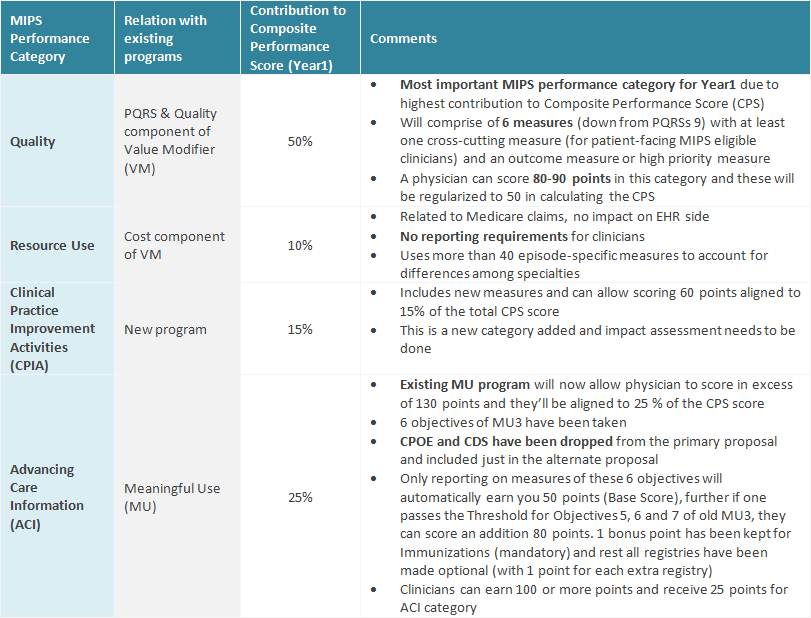MACRA overview
The proposed rule would implement changes in the Medicare Access and CHIP Reauthorization Act (MACRA) through a framework called the Quality Payment Program (QPP) which includes two paths:
- Merit-based Incentive Payment System (MIPS) or
- Advanced Alternative Payment Model (APMs)
Eligible clinicians can participate in MIPS or meet requirements to be a qualified APM participant.
Timeline for QPP

Merit-based Incentive Payment System (MIPS) promotes better care, healthier people and smarter spending by evaluating clinician performance on quality, resource use, clinical practice improvement activities and meaningful use of certified electronic health records. MIPS broadly defines 4 performance categories:

Key observations for MIPS
- MIPS makes a mention of starting from Jan 1, 2017, onwards and plans to merge MU and PQRS into this program. It also clearly mentions that PQRS will stop from 2018 and all Medicare EPs (eligible clinicians in MIPS) will need to attest to MIPS for 2017 reporting period if they planned to report for MU. This line pretty much makes it clear that CMS has no intention to continue with the MU and the PQRS program because Stage 3 was scheduled to be arriving in 2018 and now MIPS is being said to be replacing MU in 2017 itself.
- MIPS will include a positive, neutral and negative payment adjustment and also an extra bonus payment for exceptional performance by any EC.
- MU3 may be dead, but the objectives in MIPS are mapped to the final rule of MU3, so all the changes scheduled for MU3 will go on with the only difference being that they’ll be reported for MIPS and not MU.
- Failure of the 1st measure Protect ePHI of ACI will lead to scores of 0 in both base and performance scores.
- Quality measures would be selected annually through a call for quality measures process. A final list of quality measures will be published in the Federal Register by November 1 of each year. All quality measures will be aligned in the Quality Performance category. Quality measures from PQRS, Clinical Quality Measures (CQMs)and VM will find their place in this category.
- Huge allocation to Quality (50%) makes PQRS the lead program for MIPS. Changes from current PQRS program includes a reduction in the number of measures with no domain requirement and greater emphasis on outcome measurement.
- Just 25% allocation to ACI shows decreased focus on the existing MU program and its measures.
- Quality performance category has been reduced to 6 measures down from 9 (PQRS) and ACI sees a reduction from 8 objectives to 6.
- Assigning only 1 point to Immunizations (where physicians can score 50 by just reporting and not even passing the threshold) and assigning just 1 extra point for each extra registry gives the impression that CMS is not going to focus on the public health registries
- Inside the ACI category, assigning 50 points just for reporting the 6 measures shows an even decreased overall focus passing thresholds of the existing MU program.
- Further in ACI category, assigning a large share of the total points to just 3 objectives (80 out of a possible 130 points for passing threshold of objectives 5, 6 and 7 of existing MU3) shows the focus on interoperability and care-coordination.
- 100 is the maximum points for the ACI category. All physicians scoring in excess of 100 will be allocated the full 25 points of the CPS irrespective of their scores
Advanced Alternative Payment Models (APMs)
APM track offers physicians stronger financial incentives, with higher annual updates and a several-year guaranteed bonus for eligible participants. Clinicians who participate in APMs would be exempted from MIPS payment adjustments.
For 2019 to 2024, clinician receives 5 percent Medicare Part B incentive payment.
From 2026, participating health care providers receive 0.75% annual update.
APM includes:
- A CMMI model under section 1115A (other than a Health Care Innovation Award)
- Medicare Shared Savings Program (MSSP)
- A demonstration under the Health Care Quality Demonstration Program or
- A demonstration required by Federal law
An Advanced APM must meet additional requirements, such as using certified EHR technology, assuming certain financial risk and using quality measures comparable to measures under MIPS.
Proposed models that qualify as Advanced APMs for 1st performance year are:
- Comprehensive End-Stage Renal Disease Care Model (Large Dialysis Organization arrangement)
- Comprehensive Primary Care Plus (CPC+)
- Medicare Shared Savings Program—Track 2
- Medicare Shared Savings Program—Track 3
- Next Generation ACO Model
- Oncology Care Model Two-Sided Risk Arrangement (available in 2018)
CMS would update this list annually to add new payment models.
Qualifying for APMs
Clinicians must meet certain volume thresholds to be a Qualifying APM Professional (QP) and to qualify for incentive payments:

Preparing for MACRA
- Technology vendors and clinicians need to understand changes in reimbursement, timing of their implementation and data submission requirements.
- MIPS uses performance measures from existing quality programs (MU, PQRS and VM) and hence healthcare clinicians should continue to focus on performance in these quality programs. Focus on adopting certified EHR technology, prepare for PQRS measures reporting and review Quality Resource and Use Reports (QRURs).
- Clinicians can choose to be a part of ACO or a physician group to qualify for APMs in order to avoid the risk of negative adjustments.
- Technology vendors should design and align eCQM reporting to meet regulatory program requirements. EHR vendors need to align with 6 MU objectives mentioned in MACRA.
To know more about our healthcare offerings and how we can help you with MACRA, please contact us at info@citiustech.com. You could also follow us on @CitiusTech, or visit us at www.citiustech.com for more updates.
References: Medicare Program: Merit-Based Incentive Payment System and Alternative Payment Model Incentive under the Physician Fee Schedule, and Criteria for Physician-Focused Payment Models (Pre-publication PDF version of proposed rule filed on 04/27/2016)




